Dr. Skowron and some staff are still very pleased with LASIK procedure perfomed on them over 20 years ago. "For anyone who has struggled with poor vision for a long time, it is a life-changing experience. Because I and some of the staff have had the procedure done, we feel we can do a better job in advising our patients regarding LASIK surgery." We provide the pre and postoperative care and only work with surgeons that have consistent excellent outcomes. Most poor LASIK results are from performing the procedure on poor candidates, either having a very dry eye, or too thin of a cornea, or a myriad of systemic conditions.
Nearsightedness, and astigmatism are the ideal refractive eye disorders that can be corrected with LASIK (laser in-situ keratomileusis) or PRK (Photo Refractive Keratectomy). Farsightedness, or Hyperopia can be corrected, but the outcomes are not as favorable.
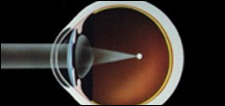
Nearsighted; focus is in front of the retina
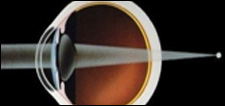
Farsighted; focus behind the retina

Astigmatism: focus split into 2 points
What Is The LASIK Procedure Like?
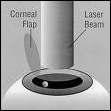
Today LASIK is a painless, totally bladeless, outpatient procedure that usually takes less than 15 minutes to perform. To start the procedure, the surgeon first creates a corneal flap with the Intralase Laser (formally used a microkeratome, a special knife). The flap is then lifted which reveals the inner corneal tissue. The Intralase laser to create the flap has made LASIK even safer and more accurate. This laser is an entirely different laser than the one that is used to reshape your eye (excimer laser) and correct your vision. This laser creates a flap that is thinner and more consistent in thickness, which provides a much better outcome. Be cautious of Laser Centers that quote a low prices as they may still be using a microkeratome (blade). Surgical skill is still the key component in the creation and repositioning of the corneal flap. Because the surface layer (epithelium) of the cornea is preserved, there is very little discomfort following LASIK surgery.
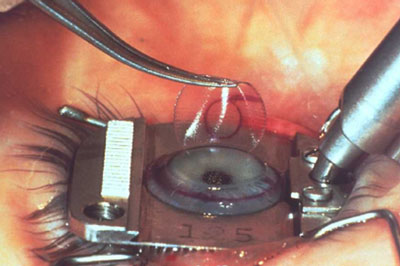
Microkeratome longer used with our LASIK doctors.
It worked similar to a manual credit card swiping plate.
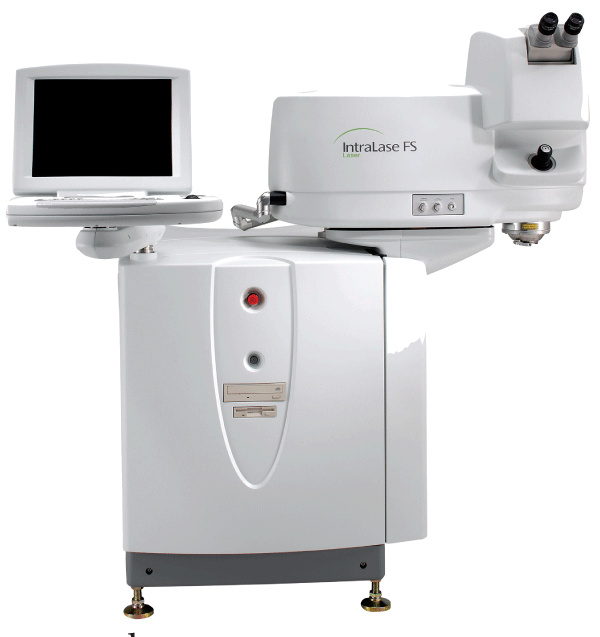
Right: A second, different (Intralase) laser is used and has eliminated most flap
complications caused by the older technolgy microkeratome.
WHAT ARE THE ADVANTAGES OF LASIK?
- A quick, painless outpatient surgery
- Less chance of infection
- Rapid recovery, usually 1-2 days
- Clear vision without corrective lenses, usually in a couple of days and sometimes within 24 hours
- Greatly reduced chance of error due to the precision of computer-assisted lasers
- Less chance of hazing
- A thinner, more precise flap obtained with the development of Intralase laser

Night glare from LASIK due to large pupils. That's why the pre-LASIK evaluation is so important to ensure you're a good candidate.
WHAT ARE THE DISADVANTAGES / RISKS OF LASIK?
- Glare, halos around bright lights, or a haze may occur for a few months. A good clinical indication that you are may experience halos is you had them with your contact lenses.
- Vision may become worse, or astigmatism may develop (usually within the first 3 months). If so, an enhancement procedure usually can be performed.
- Recovery can be uncomfortable, although this is uncommon.
- Corneal warpage if performed on a thin cornea
These risks occur less frequently with new upgraded computer LASIK programs, the use of the Intralase laser to create the flap, and careful selection of candidates for the procedure. It is important to get a thorough evaluation to determine if you are a good candidate. We have a high success rate (almost 100%) because we advise many (as much as 20%) patients against having LASIK for various reasons.

Not all patients are good candidates for LASIK
WHO IS A GOOD CANDIDATE FOR LASIK?
- Those who are myopiic (nearsighted) or have an astigmatism.
- Over 21, and no prescription changes for at least 2 years
- Some cases of farsightedness (Hyperopia)
- Healthy eyes
- Your corneas are thick enough for alteration
- You have adequate tears: do not suffer from excessive "dry eye."
- Proper postoperative expectations are explained for YOUR particular case.
WHO IS A POOR CANDIDATE FOR LASIK?
- Thin corneas, usually less than 480 microns (1000 microns to 1 millimeter); PRK then recommended
- Eye prescription continually changing / Amblyopia (lazy eye)
- Very dry eyes / Sjogren's Syndrome
- Pregnant or planning pregnancy within 6 months / or nursing
- Rheumatoid arthritis / Lupus / Collagen vascular disease
- Healing problems (keloid formation)
- Diabetes
- Keratoconus / Corneal Disease / Corneal Scarring / Herpes Zoster
- Cataracts
- Very Large pupils (can cause halos)
- Certain medications
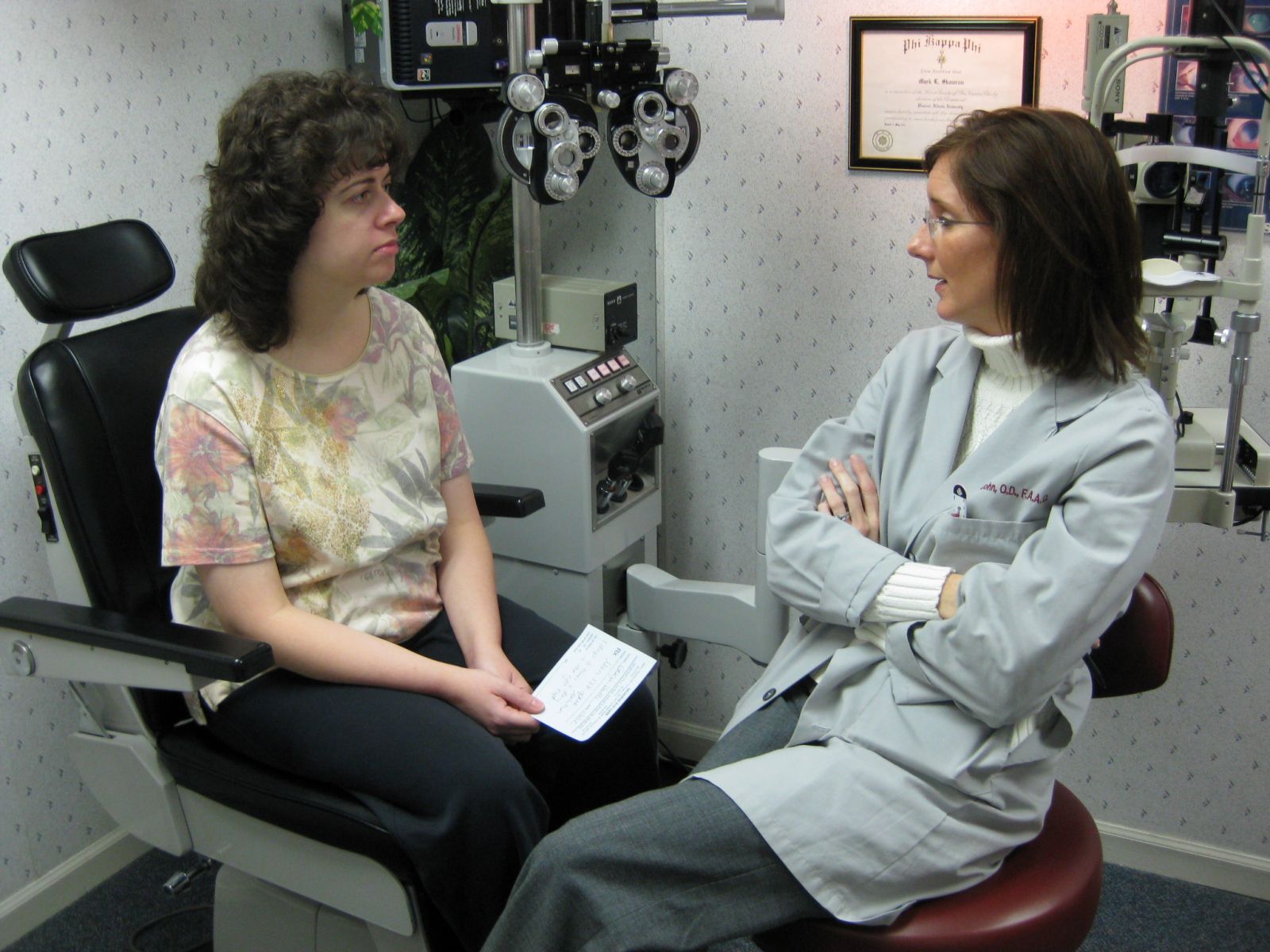
We will discuss
refractive surgical options
OUR CONSULTATION
In our consultation and examination, you'll feel confident in understanding the entire LASIK procedure from start to finish. If needed, we will place contact lenses on your eye to demonstrate how your reading and distance vision will be the following LASIK. This is especially important for those patients older than 40 who will soon need reading glasses. You may even be able to take these lenses home and see if you would be satisfied with the results. Some patients return and choose not to have the procedure. When that happens, we feel we have done our job. At Skowron Eyecare, we will take the extra time to make sure you will be happy with your LASIK outcome.
CONTACT LENS PROTOCOL:
If you wear contact lenses, there are certain criteria that need to be met prior to LASIK.
- Rigid Gas Permeable Contact Lenses
Wearing gas permeable lenses must be discontinued so the cornea can stabilize. It usually takes a month of stabilization per decade of wear. Gas permeable lenses act like braces on your teeth. Following the removal of braces, teeth shift for a while. The same thing happens to your cornea once you stop wearing gas permeable lenses. LASIK can not, and should not be performed until we are as certain that the eyes are stable. - Soft Lenses (including Disposables)
These lenses need to be off the eye for 1-2 weeks prior to surgery.
SUMMARY OFOF LASIK SURGERY
CUSTOM LASIK WITH INTRALASE LASER:
- Performed as a completely bladeless surgery
- Minimizes flap complications (safest) by the use of the Intralase laser
- Uses the latest software tracking technology. The laser stops if you accidentally look away.
- Uses an upgraded computer-driven program to reshape the eye.
- Corrects for additional distortions
- Minimizes chance for halos
- Can sometimes obtain better than 20/20 vision
Photorefractive Keratometry (PRK)
PRK is a painless, 20-minute outpatient procedure and is done if your CORNEA IS TOO THIN for LASIK as determined from your initial consultation. The creation of the flap takes up a certain amount of cornea tissue. If your cornea is too thin and LASIK is done, you may end up corneal distortion or warpage in the future, which could permanently impair your vision. In very rare cases, a corneal transplant would be needed to correct for the distortion. However, NO ONE HAS EVER GONE BLIND FROM LASIK or PRK. If your corneas are too thin, the laser surgeon will gently remove the top layer (epithelium) from the eye. The laser procedure is then performed to reshape your cornea just as if you were having LASIK. A bandage contact lens is placed on the eye for 3-5 days. Vision will be slightly blurred until this top layer regenerates. Eyedrops will be used to minimize any foreign body sensation.
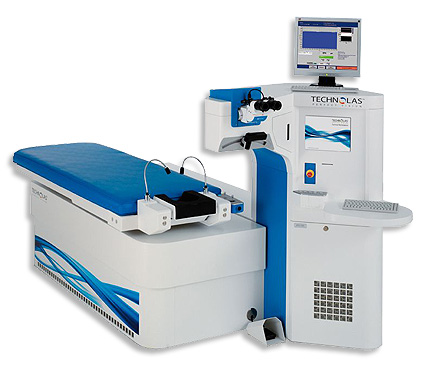
Excimer Laser (corrects the vision by reshaping)
WHAT ARE THE DISADVANTAGES OF PRK OVER LASIK?
- There is slight discomfort (eye feels gritty for a few days after the procedure. The procedure itself is painless.
- You need to wear a bandage contact lens, which calls for more frequent office follow ups.
- Vision clarity takes days to weeks.
- There is a slight increase in infection.
THE ROLE OF SKOWRON EYECARE
- Pre-Opt evaluation: Determination if good candidate, and the results you could expect.
- Post-procedure care: To ensure that the eye is healing properly and that you have obtained the results desired

Double checking measurements
before LASIK.
During our pre and post operative care, we will:
- Assess the thickness of your cornea.
- To ensure that there are no underlying pathologies that would impact the LASIK result and are contraindicated.
- Ensure that you have adequate tears to support the procedure.
- Allow you to see and experience what the end result of LASIK or PRK would be (with contact lenses)
- Provide the surgeon with your eye history, accurate clinical findings, and precise target prescription.
- Provide your post-procedure follow-up care
- To ensure you are healing properly.
- Any needed communication with the LASIK surgeon
- Prescribe lenses for reading or night driving if needed.
- Monitor the health of your eyes at your annual comprehensive eye exam
FREQUENTLY ASKED QUESTIONS
How do I prepare for my procedure?
There are no food, drink, or medication restrictions immediately prior to your procedure. However, you should avoid alcohol and medications that cause drowsiness. Contact lenses change the shape of your cornea. Since this is the area that's treated, it's important to leave your lenses out for a prescribed period of time for your cornea to return to its normal curvature.
When do I have to remove my Contact Lenses?
- Soft contact lenses should be removed at least 1- 2 weeks before your procedure.
- Hard or gas permeable contact lenses should be removed at least 4 to 6 weeks before your procedure.
- Patients who have worn rigid contact lenses for over 20 years may need to remove them for up to 3 months or more until we determine that the vision has become stable. You can be refit into soft disposable lenses while in this transition period.
Will my vision be corrected forever?
YES. However, LASIK does not guarantee your vision will remain the same forever. Your eye can still change. As long as that does not occur, the 20/20 LASIK results will remain indefinitely. We have thousands of patients that have had LASIK over 20 years ago and are still seeing 20/20. In addition, clinical studies have shown NO long-term effects of LASIK. That is why laser vision correction has become the most commonly performed refractive procedure in the world. Following an initial healing period of two to three months, the effect of the treatment is lifelong. It is uncommon, but if a regression of the nearsightedness occur, it usually happens within the first 90 days of healing, which can be fully corrected with a second enhancement procedure.
What happens on the day of my procedure?
It's natural to feel a mixture of eager anticipation and nervousness before your procedure. On the day of your procedure, you should arrive at the Laser Center as rested and relaxed as possible. Please allow approximately two to four hours for the entire process.
- Wear comfortable clothing.
- DO NOT wear eye makeup, perfume, hairspray.
- DO NOT wear any jewelry or earrings.
- Bring someone to drive you home, or make other arrangements for transportation.
The success of your laser procedure depends on our accuracy, the skill of the laser surgeon, and also the safety, accuracy, and sophistication of the equipment. At Skowron Eye Care our primary objective is to provide you with the most advanced technology, best results, and greatest degree of safety available. Automated, state-of-the-art equipment is used to test your vision, measure, and map determine your cornea health by measuring over 6,000 separate points, creating a 3D topographical map of the shape of your eye.
Immediately prior to your procedure, your eyelids and lashes will be cleaned. Antibiotic, anti-inflammatory, and anesthetic drops will be placed in your eyes. A mild sedative may be given. Once you are prepared for your procedure, you will be escorted to the laser suite for treatment. The information from your eye exam is used to program the advanced computer software. The computer calculates the required corneal change and directs the laser to make this change. The surgeon programs and operates the laser, maintaining control throughout your entire procedure.
What's the actual LASIK procedure like?
You will enter the laser room and lie down on a reclining chair below a microscope that is part of the laser. Numbing drops will be instilled into your eye to make the procedure totally painless. An eyelid holder will be placed between your eyelids to prevent you from blinking. Your other eye not being operated on will be covered. You will be asked to stare at a light. You may feel slight pressure but no discomfort during the creation of the flap. As a perfectly normal part of this procedure, your vision will become dark or blackout for a few seconds. After the laser creates the flap, you will be able to see the fixation light again.
When you look up into the laser, you will see a green or red light with a ring of lights around it. Your surgeon will ask you to look directly at this “fixation” light while the procedure is performed. The corneal flap will be lifted and folded back. By programming your pre-LASIK information into the computer, the software will direct the laser on how much corneal tissue needs to be reshaped. It could take as little as 5 to as long as 40 seconds to properly reshape your eye. The surgeon then uses his skill to reposition the flap and ensures that it is tightly secured without folds or wrinkles. At this point, then the other eye is prepped and goes through the same procedure.You will be given eyedrops with instructions and a pair of goggles to wear during sleep for about a week to protect against injuring the flap from eye rubbing. You will be instructed to see us the following day.
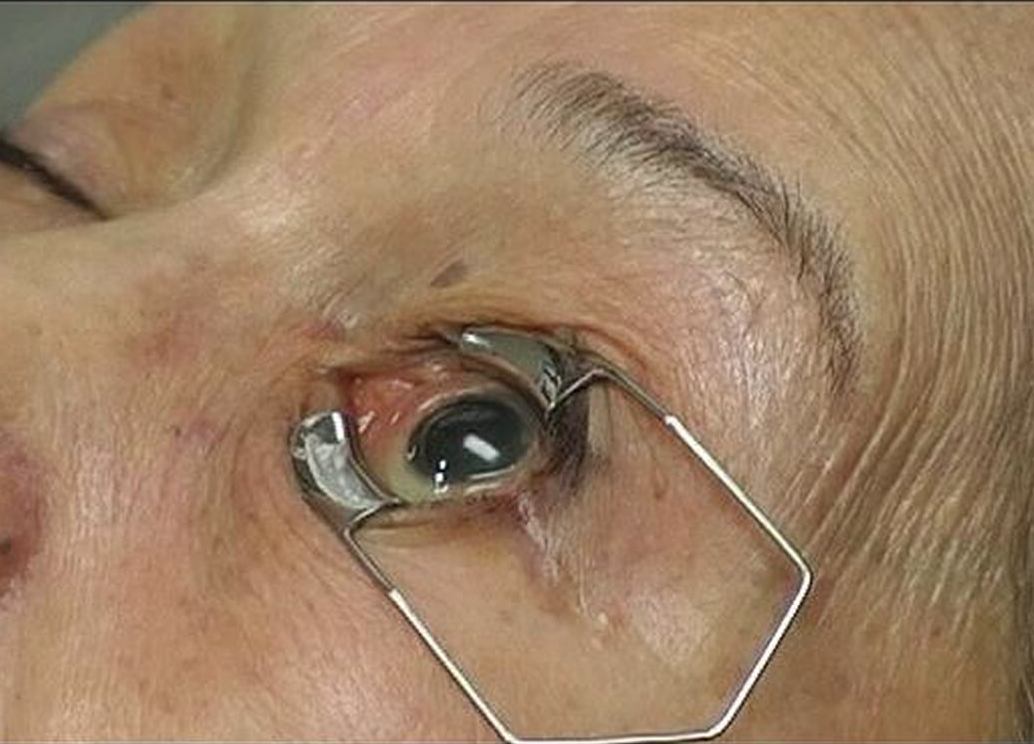
An eyelid holder
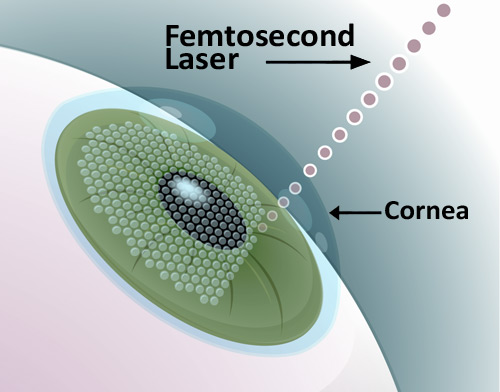
Intralase laser creates the
flap with gas bubbles
What will my recovery be like?
Most patients notice dramatic visual results after the first day following their LASIK procedure. However, the speed of visual recovery depends on personal healing patterns of each individual patient. Immediately after the surgery, your vision will still be somewhat blurred and smoky, almost like wearing very dirty contact lenses. Taking a nap shortly after your procedure is suggested. LASIK patients usually see quite well the next day, but patients with higher prescriptions may recover more slowly.
Will my activities be restricted?
Many patients can return to work the next day, others a few days later. You will need to restrict the activities mentioned below. Otherwise, as long as you follow your doctor's instructions, you should be free to resume all your normal activities.
- Wait one full day before taking a shower, and then be careful not to get soap or water in the eye.
- Resume driving usually after one day, as your doctor advises.
- Wear sunglasses for the first few days to keep debris from hitting your eye.
- Read and watch TV in moderation the first few.
- Do not wear eye makeup for one week.
- Do not rub your eyes for up to 6 months. You can gently rub them after one month.
- Eliminate heavy exercise for one week (we don't want any perspiration getting in the eye).
- Avoid swimming, hot tubs, and whirlpools for one week, rivers, and lakes for one month. When swimming, don't open your eyes to water for at least 6 months. If swimming for exercise, wear goggles.
- Avoid gardening and dusty environments for one week.
- Avoid contact sports that could result in an eye injury for one month.
LASIK CAN GIVE A FALSE SENSE OF SECURITY BECAUSE YOU FEEL FINE AND SEE FINE, BUT THE FLAP IS STILL VERY FRAGILE DURING THE FIRST MONTH AND CAN BE DISRUPTED. SO BE CAREFUL!!!! ERROR ON THE SIDE OF CAUTION. YOU COULD PERMANENTLY REVERSE ANY GREAT RESULTS BY BEING CARELESS!
What kind of follow-up care will I need?
We provide all the necessary follow-up care to ensure you are healing as expected. The examinations are scheduled for:
- One day
- One week
- One month
- Three months
- Six months
Patients must use prescribed antibiotic and anti-inflammatory eye drops during recovery. LASIK patients use drops for four to seven days, and PRK patients continue drops for one to four months, depending on the prescription. PRK patients have the bandage contact lens removed on the third to fifth day. Each appointment takes about five to 15 minutes. We are available 24 hours a day if you have any questions or concerns or you need attention.
Is this procedure covered by insurance or flexible benefits programs?
Because LASIK and PRK are considered elective (cosmetic), most insurance companies do not provide coverage. We encourage you to check with your provider. If your company has a flexible benefits program, LASIK or PRK can usually qualify.

